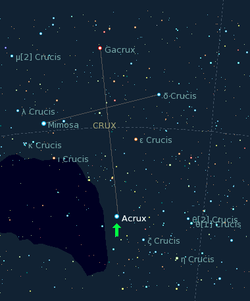Alpha Crucis
| Observation data Epoch J2000 Equinox J2000 |
|
|---|---|
| Constellation | Crux |
| Right ascension | 12h 26m 35.89522s |
| Declination | −63° 05′ 56.7343″ |
| Apparent magnitude (V) | 0.76 (1.33 + 1.75) |
| Characteristics | |
| Spectral type | B0.5IV + B1V |
| Astrometry | |
| Radial velocity (Rv) | −11.2 / −0.6 km/s |
| Proper motion (μ) |
RA: −35.83 mas/yr Dec.: −14.86 mas/yr |
| Parallax (π) | 10.13 ± 0.50mas |
| Distance | 320 ± 20 ly (99 ± 5 pc) |
| Absolute magnitude (MV) | −3.77(−2.2 + −2.7) |
| Orbit | |
| Companion | α Crucis Ab |
| Period (P) | 75.7794±0.0037 d |
| Eccentricity (e) | 0.46±0.03 |
| Periastron epoch (T) | 2417642.3±1.6 JD |
|
Argument of periastron (ω) (secondary) |
21±6° |
|
Semi-amplitude (K1) (primary) |
41.7±1.2 km/s |
| Details | |
| α1 | |
| Mass | 17.80 + 6.05 M☉ |
| Luminosity | 25,000 L☉ |
| Temperature | 24,000 K |
| Rotational velocity (v sin i) | 120 km/s |
| α2 | |
| Mass | 15.52 M☉ |
| Luminosity | 16,000 L☉ |
| Temperature | 28,000 K |
| Rotational velocity (v sin i) | 200 km/s |
| Age | 10.8 Myr |
| Other designations | |
| α1 Cru: Acrux, HR 4730, HD 108248, FK5 462, GC 16952, 26 G. Crucis | |
| α2 Cru: HR 4731, HD 108249, GC 16953, 2MASS J12263615-6305571, 27 G. Crucis | |
| Database references | |
| SIMBAD | data |
Alpha Crucis (α Crucis, abbreviated Alpha Cru, α Cru) is a multiple star system located 321 light-years from the Sun in the constellation of Crux and part of the asterism known as the Southern Cross. With a combined visual magnitude of 0.76, it is the brightest star in Crux and the 13th brightest star in the night sky. It is the southernmost first-magnitude star, just a little more southerly than Alpha Centauri.
Two components are visually distinguishable: α¹ Crucis and α² Crucis; alternatively designated α Crucis A and α Crucis B. α¹ is itself a spectroscopic binary with components designated α Crucis Aa (also named Acrux) and α Crucis Ab.
α Crucis (Latinised to Alpha Crucis) is the system's Bayer designation; α¹ and α² Crucis, those of its two constituents. The designations of these two constituents as α Crucis A and B and those of A's components - α Crucis Aa and Ab - derive from the convention used by the Washington Multiplicity Catalog (WMC) for multiple star systems, and adopted by the International Astronomical Union (IAU).
The historical name Acrux for α¹ Crucis is an 'Americanism' coined in the 19th century, but entering common use only by the mid 20th century. In 2016, the International Astronomical Union organized a Working Group on Star Names (WGSN) to catalog and standardize proper names for stars. The WGSN states that in the case of multiple stars the name should be understood to be attributed to the brightest component by visual brightness. The WGSN approved the name Acrux for α Crucis Aa on 20 July 2016 and it is now so entered in the IAU Catalog of Star Names.
...
Wikipedia

